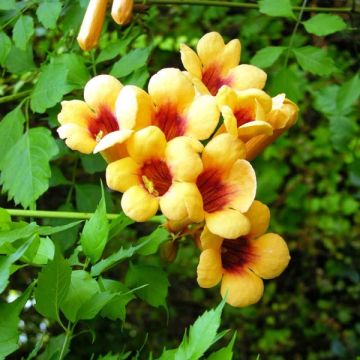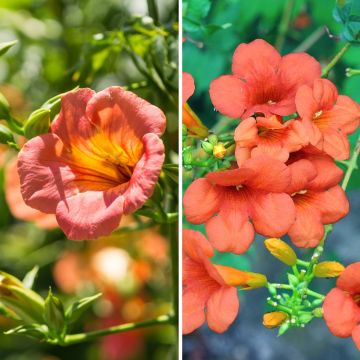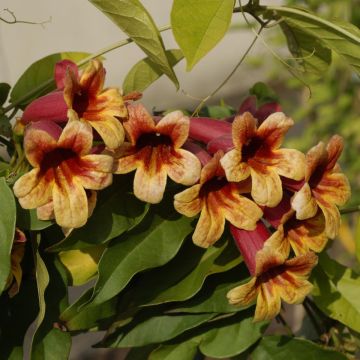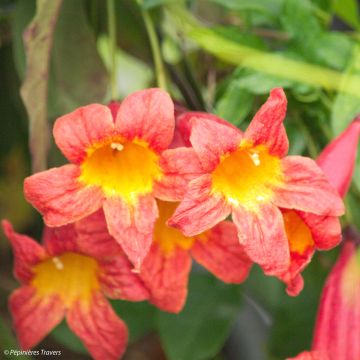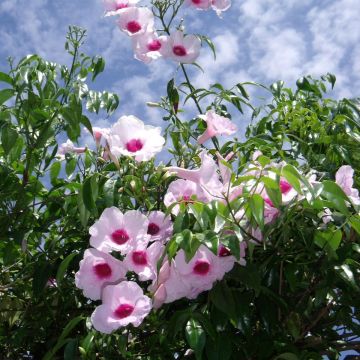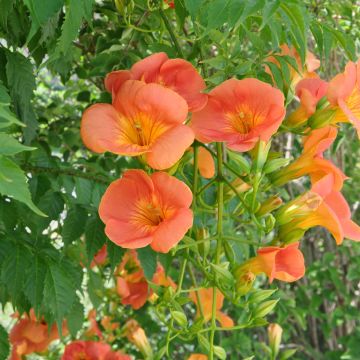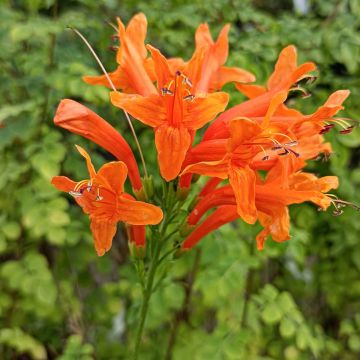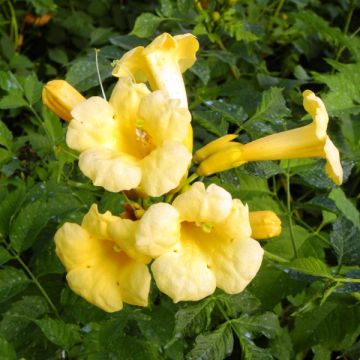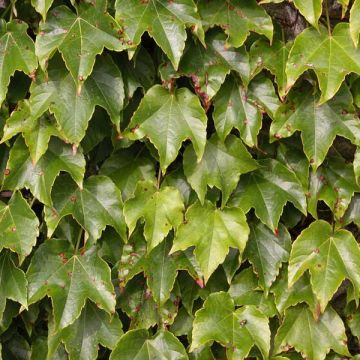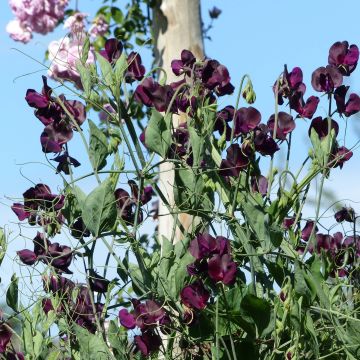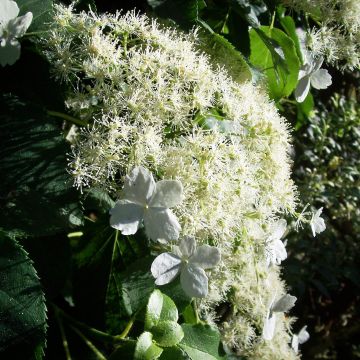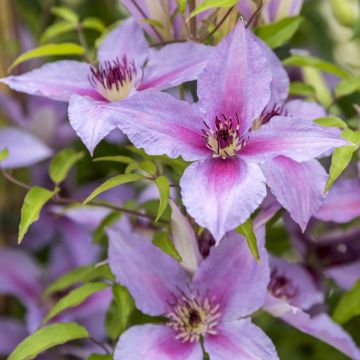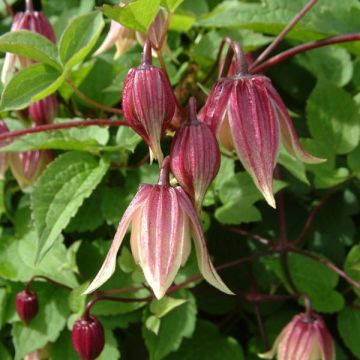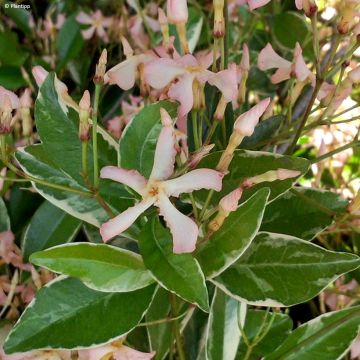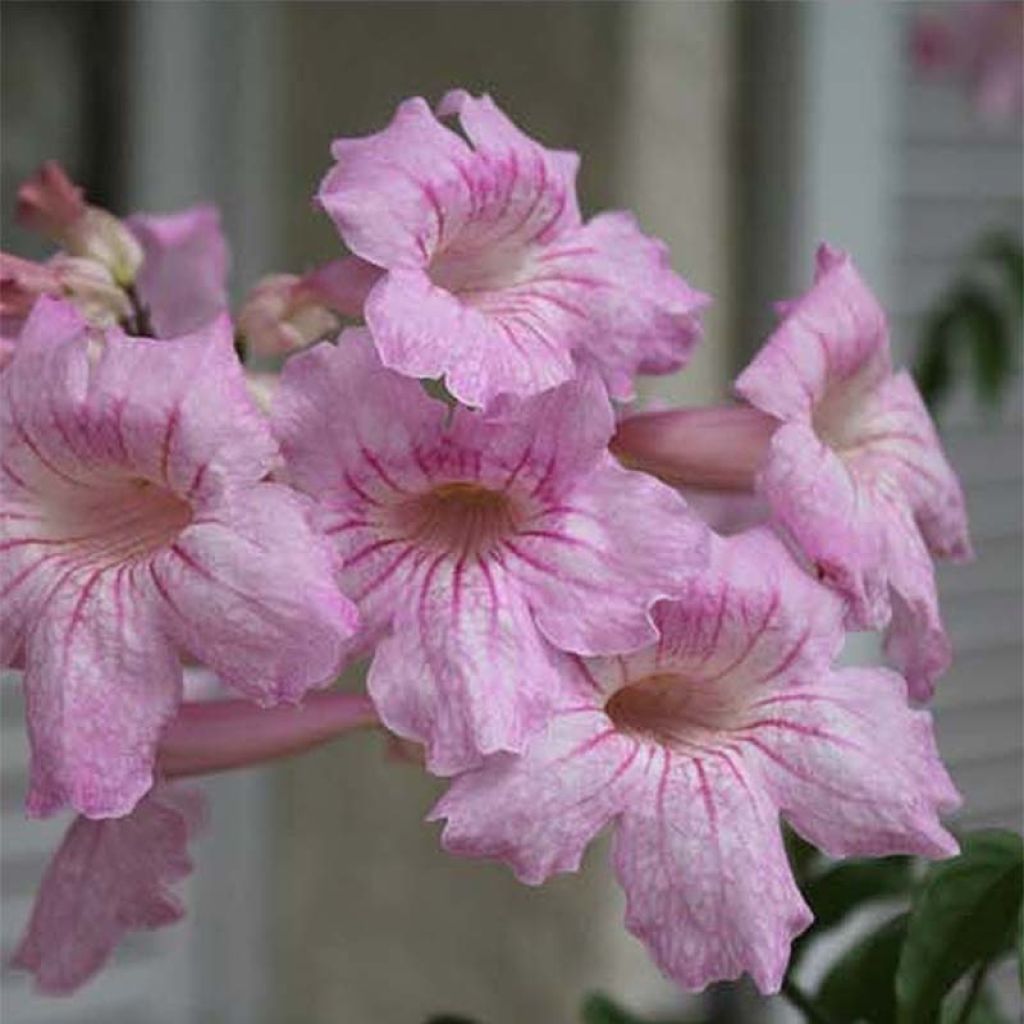

Podranea ricasoliana Comtesse Sarah
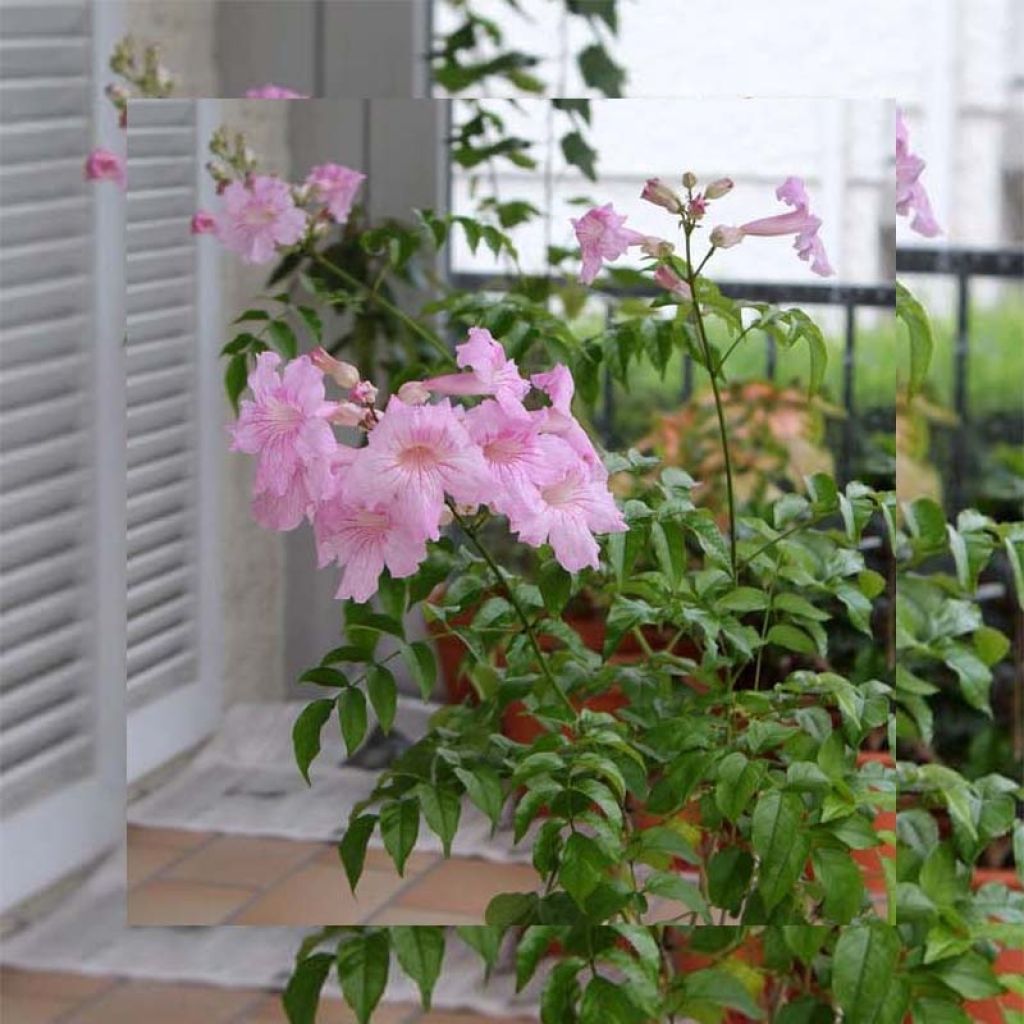

Podranea ricasoliana Comtesse Sarah
Podranea ricasoliana Comtesse Sarah
Podranea ricasoliana Comtesse Sarah
Pink Trumpet Vine, Port St John's Creeper
Plant much larger than the stated size, very healthy, appears vigorous. Very very satisfied.
Agnès, 28/05/2023
This item cannot be shipped to the selected country
Oversize package delivery charge from €6.90
More information
Schedule delivery date,
and select date in basket
This plant carries a 6 months recovery warranty
More information
We guarantee the quality of our plants for a full growing cycle, and will replace at our expense any plant that fails to recover under normal climatic and planting conditions.
Oversize package: home delivery by special carrier from €6.90 per order..
Express home delivery from €8.90.

Does this plant fit my garden?
Set up your Plantfit profile →
Description
The 'Comtesse Sarah' Pink Trumpet Vine is a rarely cultivated form of Podranea ricasoliana that differs primarily in its much earlier flowering, flowers of a more uniform pink colour and slightly smaller size, as well as lower hardiness. This old variety, whose origins are obscure, is capable of blooming as early as the beginning of summer, while its famous relative waits until the end of September to open its clusters of trumpet-shaped pink flowers. This large sarmentous shrub has quite astonishing ornamental value in mild climates and is not demanding in terms of soil or water once established. However, it requires warmth and sunlight to bloom well. It is an excellent vine for a Mediterranean garden. Elsewhere, it can be easily grown in a large container and stored during the winter.
The pink trumpet vine or Ricasoli Trumpet Vine, sometimes called orchid vine, is another species in the Bignonia family native to South Africa and Zimbabwe. 'Comtesse Sarah' is a bush with woody stump and strong sarmentous branches without a climbing system, so it will need to be trained. It grows rapidly and can reach 7 to 9 metres (23 to 29 feet) in all directions under favourable conditions, but will not exceed 3 to 4 metres (10 to 13 feet) in a pot. Annual growth is around 2 metres (7 feet) in fertile soil. The aboveground vegetation is destroyed at -3°C (26.6°F), which is why the foliage is usually deciduous in our climates. The flowering period is remarkably long. It generally starts at the end of June or beginning of July and lasts until October if the weather remains mild. The flowers bloom at the ends of the current year's shoots, grouped in ramified clusters. They have widely flared trumpet-shaped flowers, 5 cm (2in) long and 4 cm (2in) wide. Each flower consists of a tube widening into 5 rounded and undulate lobes. Their colour is a pale lilac-pink, marked with yellow and slightly striped with pink in the throat. This slightly fragrant flowering is nectar-rich and attracts bees and bumblebees. The foliage consists of 11 leaflets, fairly light green, glossy, finely toothed at the edges. If temperatures reach -5 to -6°C (23 to 21.2°F), all aboveground parts of the plant are destroyed. However, it will regrow from the stump in spring, albeit quite late.
The 'Comtesse Sarah' Pink Trumpet Vine can be used in various ways in a mild climate garden, to cover a pergola, a sparsely leaved tree in autumn, a wall sheltered from cold winds, an unsightly building, or a south-facing façade. This exotic and lush plant must be protected during the first years of cultivation. That is its only requirement, and perhaps its only weakness, as it can thrive in any deep and properly prepared soil, even limestone and relatively dry soils in summer, without hindering its joyful flowering. To accompany its blooming, consider, for example, the beautiful Clematis Prince Charles.
Report an error about the product description
Podranea ricasoliana Comtesse Sarah in pictures
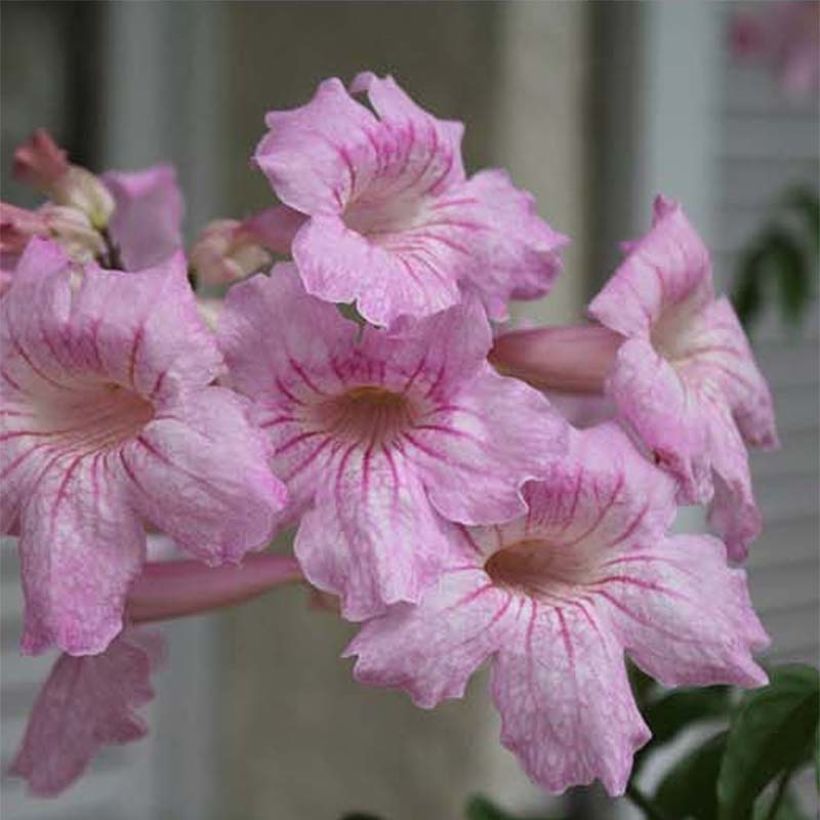

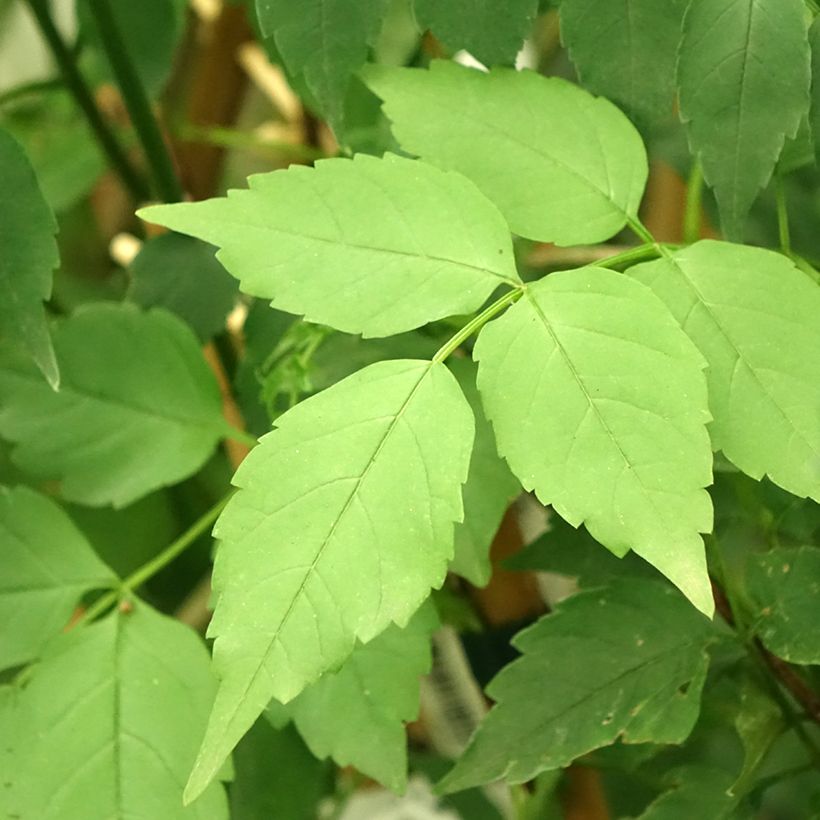

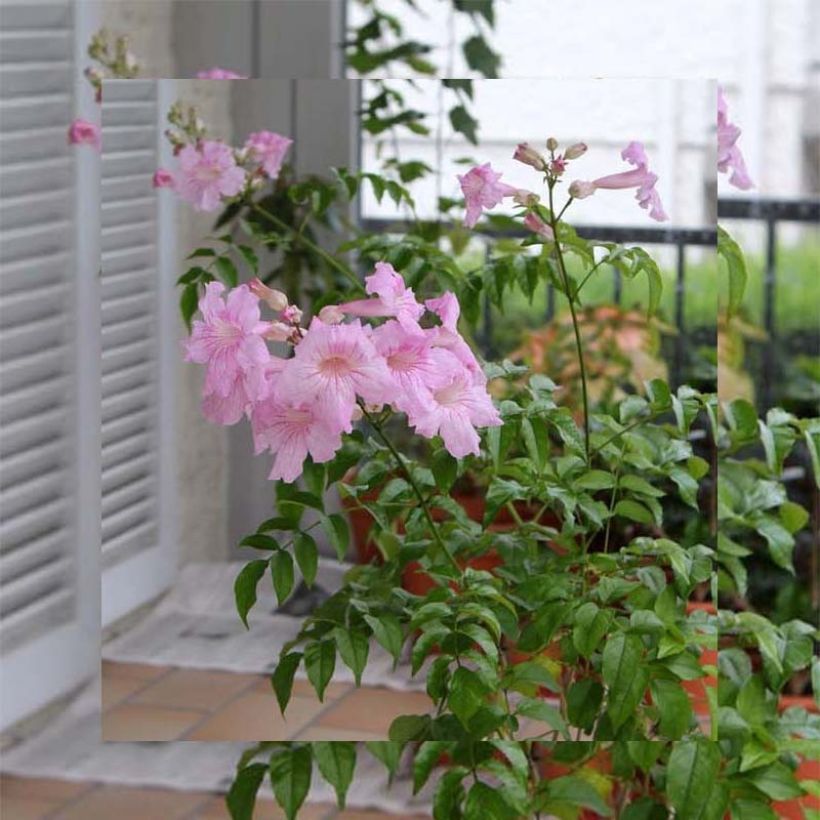

Plant habit
Flowering
Foliage
Botanical data
Podranea
ricasoliana
Comtesse Sarah
Bignoniaceae
Pink Trumpet Vine, Port St John's Creeper
South Africa
Other Campsis - Trumpet Creeper
Planting and care
The Podranea ricasoliana 'Comtesse Sarah' is a plant that is not very demanding on the type of soil, but is not very hardy (-5°C (23°F) for a mature plant). It grows well in any fairly deep garden soil, that is loose, well-drained, even quite poor and limestone. It tolerates drought once established and is resistant to wind and sea spray. In fertile soil that remains slightly moist, its growth will be enhanced and its flowering will be very abundant. It prefers a very sunny, warm exposure, except in the south of our country where it will also thrive in dappled shade. Plant it along a well-exposed wall or against a tree, training the young branches as they grow, as they are unable to attach themselves to their support. Water regularly during the first summers. If your garden is in a borderline hardiness zone, protect the base of the plant from severe frost with a thick mulch, and surround the plant with a thick winter cover. Pruning is not essential. If necessary, do it in spring. As this plant flowers on the current year's branches, if they are not pruned, they will produce secondary branches that will flower during the season. Therefore, prune while leaving a few buds on each branch.
This bignonia can be trained as a tree, just like wisteria, which is probably more practical for growing in a pot that will be protected from severe frost. If you are growing your Podranea in a pot, choose a large container with a layer of gravel at the bottom for drainage and fill it with a mixture of garden soil, leaf compost, and compost. Water regularly and abundantly in hot weather. Fertilise regularly.
Planting period
Intended location
Care
-
, onOrder confirmed
Reply from on Promesse de fleurs
Summer flowering climbers
Haven't found what you were looking for?
Hardiness is the lowest winter temperature a plant can endure without suffering serious damage or even dying. However, hardiness is affected by location (a sheltered area, such as a patio), protection (winter cover) and soil type (hardiness is improved by well-drained soil).

Photo Sharing Terms & Conditions
In order to encourage gardeners to interact and share their experiences, Promesse de fleurs offers various media enabling content to be uploaded onto its Site - in particular via the ‘Photo sharing’ module.
The User agrees to refrain from:
- Posting any content that is illegal, prejudicial, insulting, racist, inciteful to hatred, revisionist, contrary to public decency, that infringes on privacy or on the privacy rights of third parties, in particular the publicity rights of persons and goods, intellectual property rights, or the right to privacy.
- Submitting content on behalf of a third party;
- Impersonate the identity of a third party and/or publish any personal information about a third party;
In general, the User undertakes to refrain from any unethical behaviour.
All Content (in particular text, comments, files, images, photos, videos, creative works, etc.), which may be subject to property or intellectual property rights, image or other private rights, shall remain the property of the User, subject to the limited rights granted by the terms of the licence granted by Promesse de fleurs as stated below. Users are at liberty to publish or not to publish such Content on the Site, notably via the ‘Photo Sharing’ facility, and accept that this Content shall be made public and freely accessible, notably on the Internet.
Users further acknowledge, undertake to have ,and guarantee that they hold all necessary rights and permissions to publish such material on the Site, in particular with regard to the legislation in force pertaining to any privacy, property, intellectual property, image, or contractual rights, or rights of any other nature. By publishing such Content on the Site, Users acknowledge accepting full liability as publishers of the Content within the meaning of the law, and grant Promesse de fleurs, free of charge, an inclusive, worldwide licence for the said Content for the entire duration of its publication, including all reproduction, representation, up/downloading, displaying, performing, transmission, and storage rights.
Users also grant permission for their name to be linked to the Content and accept that this link may not always be made available.
By engaging in posting material, Users consent to their Content becoming automatically accessible on the Internet, in particular on other sites and/or blogs and/or web pages of the Promesse de fleurs site, including in particular social pages and the Promesse de fleurs catalogue.
Users may secure the removal of entrusted content free of charge by issuing a simple request via our contact form.
The flowering period indicated on our website applies to countries and regions located in USDA zone 8 (France, the United Kingdom, Ireland, the Netherlands, etc.)
It will vary according to where you live:
- In zones 9 to 10 (Italy, Spain, Greece, etc.), flowering will occur about 2 to 4 weeks earlier.
- In zones 6 to 7 (Germany, Poland, Slovenia, and lower mountainous regions), flowering will be delayed by 2 to 3 weeks.
- In zone 5 (Central Europe, Scandinavia), blooming will be delayed by 3 to 5 weeks.
In temperate climates, pruning of spring-flowering shrubs (forsythia, spireas, etc.) should be done just after flowering.
Pruning of summer-flowering shrubs (Indian Lilac, Perovskia, etc.) can be done in winter or spring.
In cold regions as well as with frost-sensitive plants, avoid pruning too early when severe frosts may still occur.
The planting period indicated on our website applies to countries and regions located in USDA zone 8 (France, United Kingdom, Ireland, Netherlands).
It will vary according to where you live:
- In Mediterranean zones (Marseille, Madrid, Milan, etc.), autumn and winter are the best planting periods.
- In continental zones (Strasbourg, Munich, Vienna, etc.), delay planting by 2 to 3 weeks in spring and bring it forward by 2 to 4 weeks in autumn.
- In mountainous regions (the Alps, Pyrenees, Carpathians, etc.), it is best to plant in late spring (May-June) or late summer (August-September).
The harvesting period indicated on our website applies to countries and regions in USDA zone 8 (France, England, Ireland, the Netherlands).
In colder areas (Scandinavia, Poland, Austria...) fruit and vegetable harvests are likely to be delayed by 3-4 weeks.
In warmer areas (Italy, Spain, Greece, etc.), harvesting will probably take place earlier, depending on weather conditions.
The sowing periods indicated on our website apply to countries and regions within USDA Zone 8 (France, UK, Ireland, Netherlands).
In colder areas (Scandinavia, Poland, Austria...), delay any outdoor sowing by 3-4 weeks, or sow under glass.
In warmer climes (Italy, Spain, Greece, etc.), bring outdoor sowing forward by a few weeks.


































